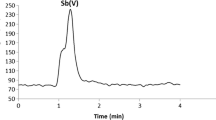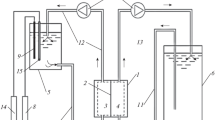Summary
The fluorescent probe ANS is a permeant anion in human red cells. The rate of ANS permeation is decreased by lyotropic anions and increased by low ionic strength, resembling the response of Cl and SO4 transport to changes in the composition of the medium. ANS inhibits Cl and SO4 exchange measured at 0 and 37°C, respectively. The inhibitory potency of ANS isomers increases in the sequence 1,8 ANS<2,8 ANS<1,4 ANS<2,6 TNS<5,2 ANS. The disulfonic stilbene derivative SITS inhibits Cl exchange 50%. Combinations of ANS and SITS result in additive inhibitory effects regardless of the ANS concentration. Combinations of dipyridamole and ANS show additive inhibitory effects only at low concentrations of the latter. The mechanisms of inhibition by ANS are discussed in terms of (1) interactions between the probe and an anion carrier and (2) modifications of the membrane surface charge by ANS. Assuming that ANS bound to the membrane surface produces a negative surface charge, ANS-dependent surface potentials of magnitude sufficient to account for the observed inhibition can be calculated using double layer theory. It is suggested that anionic amphiphiles inhibit anion and increase cation permeability through modifications of surface charge that alter the ion concentrations at the permeability barriers and a second step, affected by SITS, is involved in anion permeation.
Similar content being viewed by others
References
Bangham, A. D., Standish, M. M., Watkins, J. C. 1965. Diffusion of univalent ions across the lamellae of swollen phospholipids.J. Mol. Biol. 13:238
Cabantchik, Z. I., Rothstein, A. 1972. The nature of the membrane sites controlling anion permeability of human red blood cells as determined by studies with disulfonic stilbene derivatives.J. Membrane Biol. 10:311
Dalmark, M. 1972. The effect of temperature bicarbonate-carbon dioxide and pH on the chloride transport across the human erythrocyte membrane.In: Oxygen Affinity of Hemoglobin and Red Cell Acid Base Status. M. Rørth and P. Astrup, editors. p. 320. Munksgaard, Copenhagen
Dalmark, M., Wieth, J. O. 1972. Temperature dependence of chloride, bromide, iodide, thiocyanate and salicylate transport in human red cells.J. Physiol. 224:583
Davies, J. T., Rideal, E. K. 1963. Interfacial Phenomena. Academic Press Inc., New York
Deuticke, B. 1970. Anion permeability of the red blood cell.Naturwissenschaften 57:172
Ehrenspeck, G., Passow, H. 1973. Halide fluxes in liposomes made from red blood cells.In: Erythrocytes, Thrombocytes, Leukocytes: Recent Advances in Membrane and Metabolic Research. E. Gerlach, K. Moser, E. Deutsch, and W. Wilmanns, editors. p. 80. Georg Thieme Publishers, Stuttgart
Fortes, P. A. G. 1972. Structural Properties of the Human Red Cell Membrane and Mechanisms of Anion Permeability Studied with Fluorescent Probes. Ph. D. Thesis. University of Pennsylvania, Philadelphia, Pa.Diss. Abstr. Int. B 33(7):2961
Fortes, P. A. G., Hoffman, J. F. 1971. Interactions of the fluorescent anion 1-anilino-8-naphthalene sulfonate with membrane charges in human red cell ghosts.J. Membrane Biol. 5:154
Fortes, P. A. G., Hoffman, J. F. 1973. Inhibition of anion permeability in the human red cell by fluorescent probes.In: Erythrocytes, Thrombocytes, Leukocytes: Recent Advances in Membrane and Metabolic Research. E. Gerlach, K. Moser, E. Deutsch, and W. Wilmanns, editors. p. 92. Georg Thieme Publishers, Stuttgart
Fortes, P. A. G., Yguerabide, J., Hoffman, J. F. 1972a. Nanosecond fluorescence spectroscopy of ANS in red cell ghosts.Biophys. Soc. Abstr. 255a
Fortes, P. A. G., Yguerabide, J., Hoffman, J. F. 1972b. Membrane properties and the mechanism of anion permeability in human red cells as studied with fluorescent probes.Abstr. IV Int. Biophys. Congr., Moscow3:135
Freedman, R. B., Radda, G. K. 1969. The interaction of 1-anilino-8-naphthalene sulfonate with erythrocyte membranes.FEBS Letters 3:150
Gardos, G., Hoffman, J. F., Passow, H. 1969. Flux measurements in erythrocytes.In: Laboratory Techniques in Membrane Biophysics. H. Passow and R. Stampfli, editors. p. 9. Springer-Verlag, Berlin, Heidelberg
Gunn, R. B. 1972. A titratable carrier model for both mono- and divalent inorganic anions in red blood cells.In: Oxygen Affinity of Hemoglobin and Red Cell Acid Base Status. M. Rørth and P. Astrup, editors. p. 823. Munksgaard, Copenhagen
Gunn, R. B. 1973. A titratable carrier for monovalent and divalent inorganic anions in red blood cells.In: Erythrocytes, Thrombocytes, Leukocytes: Recent Advances in Membrane and Metabolic Research. E. Gerlach, K. Moser, E. Deutsch, and W. Wilmanns, editors. p. 77. Georg Thieme Publishers, Stuttgart
Gunn, R. B., Dalmark, M., Tosteson, D. C., Wieth, J. O. 1973. Characteristics of chloride transport in human red blood cells.J. Gen. Physiol. 61:185
Gunn, R. B., Tosteson, D. C. 1971. The effect of 2,4,6-trinitro-m-cresol on cation and anion transport in, sheep red cells.J. Gen. Physiol. 57:593
Harris, E. J., Pressman, B. C. 1967. Obligate cation exchanges in red cells.Nature 216:918
Haydon, D. A., Myers, V. B. 1973. Surface charge, surface dipoles and membrane conductance.Biochim. Biophys. Acta 307:429
Haynes, D. H. 1972. 1-amino-8-naphtyl sulfonate as an indicator of membrane structure and surface potential.Abstr IV Int. Biophys. Congr., Moscow3:252
Henderson, P. J. F., McGivan, J. D., Chappell, J. B. 1969. The action of certain antibiotics on mitochondrial, erythrocyte and artificial phospholipid membranes. The role of induced proton permeability.Biochem. J. 111:521
Hoffman, J. F., Lassen, U. V. 1971. Plasma membrane potentials inAmphiuma red cells.Abstr. XXV Int. Physiol. Congr. Munich, p. 253
Hunter, M. J. 1971. A quantitative estimate of the non-exchange-restricted chloride permeability of the human red cell.J. Physiol. 218:49P
Knauf, P. A., Rothstein, A. 1971. Chemical modification of membranes. I. Effects of sulfhydryl and amino reactive reagents on anion and cation permeability of the human red blood cell.J. Gen. Physiol. 58:190
Lassen, U. V. 1972. Membrane potential and membrane resistance of red cells.In: Oxygen Affinity of Hemoglobin and Red Cell Acid Base Status. M. Rørth and P. Astrup, editors. p. 291. Munksgaard, Copenhagen
Lepke, S., Passow, H. 1971. The permeability of the human red blood cell to sulfate ions.J. Membrane Biol. 6:158
Lesslauer, W., Cain, J., Blasie, J. K. 1971. On the location of 1-anilino-8-naphthalene-sulfonate (ANS) in lipid model systems. An X-ray diffraction study.Biochim. Biophys. Acta 241:547
Maddy, A. 1964. A fluorescent label for the outer components of the plasma membrane.Biochim. Biophys. Acta 88:390
McLaughlin, S. G. A., Szabo, G., Eisenman, G. 1971. Divalent ions and the surface potential of charged phospholipid membranes.J. Gen. Physiol. 58:667
Pagano, R., Thompson, T. E. 1968. Spherical lipid bilayer membranes: Electrical and isotopic studies of ion permeability.J. Mol. Biol. 38:41
Passow, H. 1969. Passive ion permeability of the erythrocyte membrane.Prog. Biophys. Mol. Biol. 19:425
Passow, H. 1971. Effects of pronase on passive ion permeability of the human red blood cell.J. Membrane Biol. 6:233
Passow, H., Schnell, K. F. 1969. Chemical modifiers of passive ion permeability of the erythrocyte membrane.Experientia 25:460
Poensgen, J., Passow, H., 1971. Action of 1-fluoro-2,4-dinitrobenzene on passive ion permeability of the human red blood cell.J. Membrane Biol. 6:210
Rubalcava, B., Martinez de Muñoz, D., Gitler, C. 1969. Interaction of fluorescent probes with membranes. I. Effect of ions on erythrocyte membranes.Biochemistry 8:2742
Scarpa, A., Cecchetto, A., Azzone, G. F. 1970. The mechanism of anion translocation and pH equilibration in erythrocytes.Biochim. Biophys. Acta 219:179
Stryer, L. 1968. Fluorescence spectroscopy of proteins.Science 162:526
Szabo, G., Eisenman, G. 1973. Enhanced cation permeation in glyceryl oleate bilayers.Biophys. Soc. Abstr., 175a
Tosteson, D. C. 1959. Halide transport in red blood cells.Acta. Physiol. Scand. 46:19
Tosteson, D. C., Gunn, R. B., Wieth, J. O. 1973. Chloride and hydroxyl ion conductances in sheep red cell membranes.In: Erythrocytes, Leukocytes, Thrombocytes: Recent Advances in Membrane Research. E. Gerlach, K. Moser, E. Deutsch, and W. Wilmanns, editors. p. 62. Georg Thieme Publishers, Stuttgart
Wieth, J. O., 1970. Effect of some monovalent anions on chloride and sulphate permeability of human red cells.J. Physiol. 207:581
Wieth, J. O., Dalmark, M., Gunn, R. B., Tosteson, D. C. 1973. The transfer of monovalent inorganic anions through the red cell membrane.In: Erythrocytes, Thrombocytes, Leukocytes: Recent Advances in Membrane and Metabolic Research. E. Gerlach, K. Moser, E. Deutsch, and W. Wilmanns, editors. p. 71. Georg Thieme Publihsers, Stuttgart
Wood, P. G., Passow, H. 1971. Iodide transport in the human red blood cell.Abstr. XXIII Int. Congr. Physiol. Sci., Munich. p. 608
Author information
Authors and Affiliations
Rights and permissions
About this article
Cite this article
Fortes, P.A.G., Hoffman, J.F. The interaction of fluorescent probes with anion permeability pathways of human red cells. J. Membrain Biol. 16, 79–100 (1974). https://doi.org/10.1007/BF01872408
Received:
Issue Date:
DOI: https://doi.org/10.1007/BF01872408




